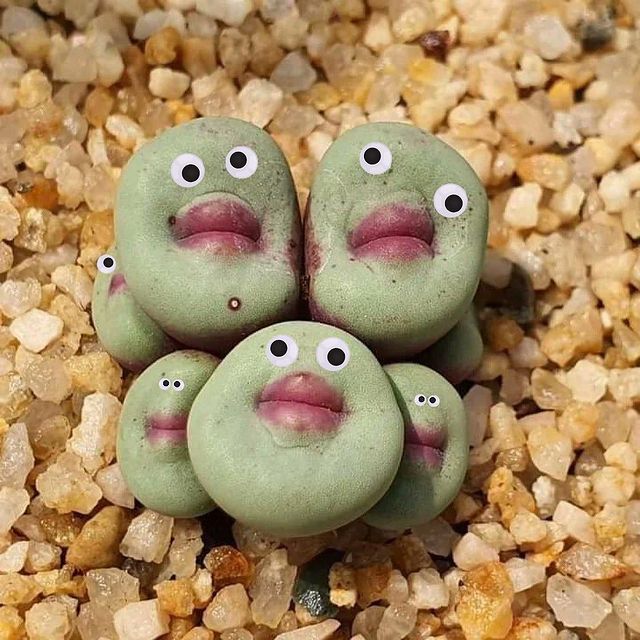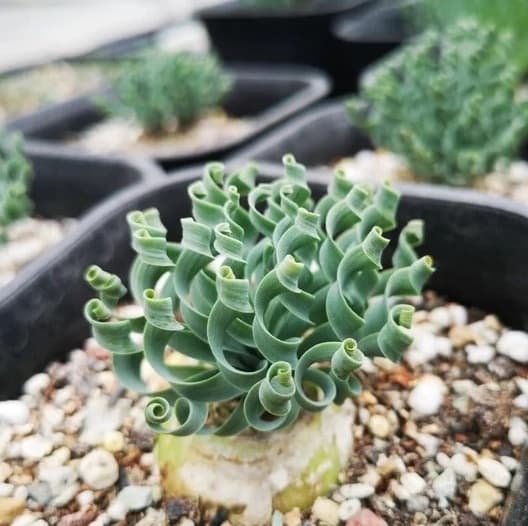Conophytum Pageae
Posted by Grace on February 23, 2023
If you're on the lookout for an adorable and unique plant to add to your collection, then you'll want to take a closer look at Conophytum pageae. This small succulent is known for its charming appearance that resembles a pair of plump, pouting lips. Beyond its charming appearance, this plant has a lot to offer, making it a great addition to any plant lover's collection.
In this article, we'll dive into everything you need to know to care for this delightful plant, from the ideal growing conditions to propagation methods. So, let's explore the world of Conophytum pageae together!
If you're interested in other types of Conophytum, check out the entire collection in My Complete Conophytum Identification Guide!
Quick Facts
- Native Habitat: Namaqualand region of South Africa 🇿🇦
- Family: Aizoaceae
- Water: Water sparingly during the growing season
- Sunlight: Thrives in full sun
- Soil: Well-draining soil mix to mimic its natural habitat
Contents
- Why it is called Conophytum Pageae?
- The Appearance of Conophytum Pageae
- Care for Conophytum pageae
- Propagation of Conophytum pageae
- Common Problems of Conophytum pageae
- FAQ
- Bonus!
Why it is called Conophytum Pageae?
Conophytum pageae is a fascinating succulent plant from the Aizoaceae family. It is endemic to the Namaqualand region of South Africa.
Conophytum pageae was named in honor of Mary Maud Page, an English botanist who relocated to South Africa in 1911 to study the plant life there.
Fun fact: many other plants were named after Mrs. Page, such as Pagella Schönland, Nemesia pageae, Crassula pageae, Erica pageana, Psilocaulon pageae (now P. dinteri), Carpobrotus pageae (now C. mellei), and Erepsia pageae (now E. patula), and possibly also for Amphithalea pageae and Muraltia pageae.
The Appearance of Conophytum Pageae
Leaves
Conophytum pageae grow in clusters or as stemless "bodies" that are about 1" (2.5 cm) high, shaped like a fig or an inverted cone. Each body consists of two fused, dull, gray-green leaves with a puckered fissure at the top, ringed in red, resembling two lips.
 Conophytum pageae look like kissing each other (Source)
Conophytum pageae look like kissing each other (Source)
Flowers
The flowers of Conophytum Pageae are typically yellow, pink, or purple in color, and they bloom in the late summer or early fall.
The flowers of Conophytum Pageae are quite small, measuring only a few millimeters in diameter. However, despite their small size, they are incredibly intricate and complex. Each flower has several petals that form a star shape, and the center of the flower is filled with delicate stamens and pistils. The petals themselves are often striped or spotted, adding to the beauty and uniqueness of the flower.
Care for Conophytum pageae
In the wild, Conophytum pageae grows in rocky areas with well-drained soil. It is adapted to survive in harsh desert conditions, where it can go for months without water. To grow this plant successfully, it is recommended to mimic its natural habitat by providing it with a well-draining soil mix and watering it sparingly during the growing season.
Sunlight
Conophytum pageae needs plenty of bright, indirect sunlight to grow well. It should be placed in a location that receives at least six hours of sunlight per day. This succulent plant prefers a south or west-facing window, but it can also be grown under grow lights if natural light is not available. However, it's important to avoid direct sunlight, which can cause sunburn on the plant's leaves.
Water
Conophytum pageae is a succulent plant that can store water in its leaves, making it resistant to drought. Overwatering can lead to root rot and other issues, so it's essential to avoid it. Water your Conophytum pageae sparingly, allowing the soil to dry out completely between waterings. During the winter months, you may be able to reduce watering even further.
Temperature
Conophytum pageae prefers warm temperatures and should be kept away from drafts or extreme temperature changes. Ideally, your plant should be kept in a location with temperatures between 60-85°F.
Soil
Conophytum pageae prefers a well-draining mix that is rich in organic matter. You can use a commercial succulent potting mix or create your own mix using equal parts sand, perlite, and peat moss. This plant is susceptible to root rot, so it's important to ensure that the soil is well-draining and not waterlogged.
Air Humidity
Conophytum pageae is adapted to dry, arid conditions and does not require high levels of humidity. In fact, excessive humidity can be harmful to the plant, as it can increase the risk of fungal infections and other issues. Aim for a relative humidity level of 30-50% in the room where your Conophytum pageae is located.
Fertilizing
Conophytum pageae does not require frequent fertilization, but you can feed it once or twice a year with a balanced, water-soluble fertilizer. Be sure to dilute the fertilizer according to the instructions on the label, and only apply it during the plant's active growing season.
Repotting
Conophytum pageae grows slowly and may only need to be repotted every few years. When repotting, be sure to use a pot that is only slightly larger than the current one, and be careful not to damage the plant's delicate roots.
Pruning
Conophytum pageae does not require frequent pruning, but you may want to remove any dead or yellowing leaves as needed. Be sure to use clean, sharp scissors or pruning shears, and avoid damaging the healthy leaves or stem.
Propagation of Conophytum pageae
There are a few ways to propagate Conophytum pageae:
Leaf cuttings
Gently remove a healthy leaf from the plant and let it dry out for a few days until a callus forms over the cut end. Plant the cutting in well-draining soil mix and water sparingly until new growth appears.
Division
When repotting your Conophytum pageae, you can divide the plant into smaller clumps and pot them separately. Be sure to handle the roots gently and plant the new clumps in fresh, well-draining soil.
Seed propagation
Conophytum pageae can be grown from seed, although this method requires more patience and attention. Sow the seeds in well-draining soil mix and keep them moist until they germinate. It can take several weeks or months for the seedlings to appear, and they may require extra care and attention as they grow.
Need tools for succulent propagation and repotting? Here are my go-to tools: mini tool set (including syringe 💉, gloves 🧤, tweezers 🪤, dust blower 💨, tiny shovels 🛠️) and well-draining mix 🌱.Common Problems of Conophytum pageae
While Conophytum pageae is a relatively easy plant to care for, it can still experience some problems that may affect its growth and appearance. Here are some common issues that you may encounter with this plant:
Overwatering
Conophytum pageae is a succulent plant that is adapted to dry conditions. If the plant is watered too frequently or the soil is kept too wet, it can develop root rot, which can eventually kill the plant. It's important to allow the soil to dry out completely between waterings. Underwatering: While it's important not to overwater Conophytum pageae, it also requires some moisture to thrive. If the plant is not watered enough, its leaves may start to shrivel and dry out.
Pest infestations
Like any plant, Conophytum pageae is susceptible to pests such as mealybugs, spider mites, and scale insects. These pests can cause damage to the plant by sucking sap from the leaves and stems. If you notice any signs of a pest infestation, such as webbing or sticky residue on the leaves, treat the plant with an insecticidal soap.
Fungal infections
Conophytum pageae can be prone to fungal infections if the soil is too moist or the plant is exposed to too much humidity. Signs of a fungal infection include brown spots on the leaves or a white powdery substance on the surface of the plant. To treat a fungal infection, remove any infected parts of the plant and improve air circulation around the plant.
Incorrect lighting
Conophytum pageae requires bright, indirect light to thrive. If the plant is not receiving enough light, its leaves may start to stretch or become pale in color. On the other hand, if the plant is exposed to too much direct sunlight, its leaves may burn or scorch. By keeping an eye out for these common problems and taking steps to address them promptly, you can help your Conophytum pageae thrive and maintain its beauty for years to come.
FAQ
Where can I find Conophytum Pageae?
Most of the world's approximately 100 species of Conophytum, also known as conos, are threatened. Some cling to a single hillside, while others are scattered over rocky outcrops, making them critically endangered. The very scarcity that makes conos so alluring to ornamental plant collectors, primarily in China but also in Japan and South Korea, puts their survival at risk.
Although Conophytum pageae may be sold online, it's important to remember that many of them are endangered and may be poached from Namaqualand, South Africa.
Read more about poached Conophytum Pageae in the article "These tiny succulents are under siege from international crime rings" on National Geographic. You can actually see confiscated clusters of Conophytum pageae there. It is disheartening to see.
The best way to find these conophytums is to visit the locations where they naturally grow, and just leave where they are.
How do you care for Conophytum Pageae?
To care for Conophytum pageae, it is important to provide it with a well-draining soil mix and water it sparingly during the growing season. This succulent plant prefers a location that receives at least six hours of bright, indirect sunlight per day and should be kept away from direct sunlight to avoid sunburn. Conophytum pageae prefers warm temperatures between 60-85°F and a well-draining mix that is rich in organic matter to avoid root rot. The plant is adapted to dry, arid conditions and does not require high levels of humidity. Fertilization is not required frequently, but you can feed it once or twice a year with a balanced, water-soluble fertilizer. Repotting may only be necessary every few years, and pruning is not needed frequently, but dead or yellowing leaves should be removed as needed.
Bonus!
Before you finish reading this article about Conophytum pageae, I want to ask: how about this look?
 Conophytum pageae with googly eyes 🤣
Conophytum pageae with googly eyes 🤣
If you're interested in other types of Conophytum, check out the entire collection in My Complete Conophytum Identification Guide!






